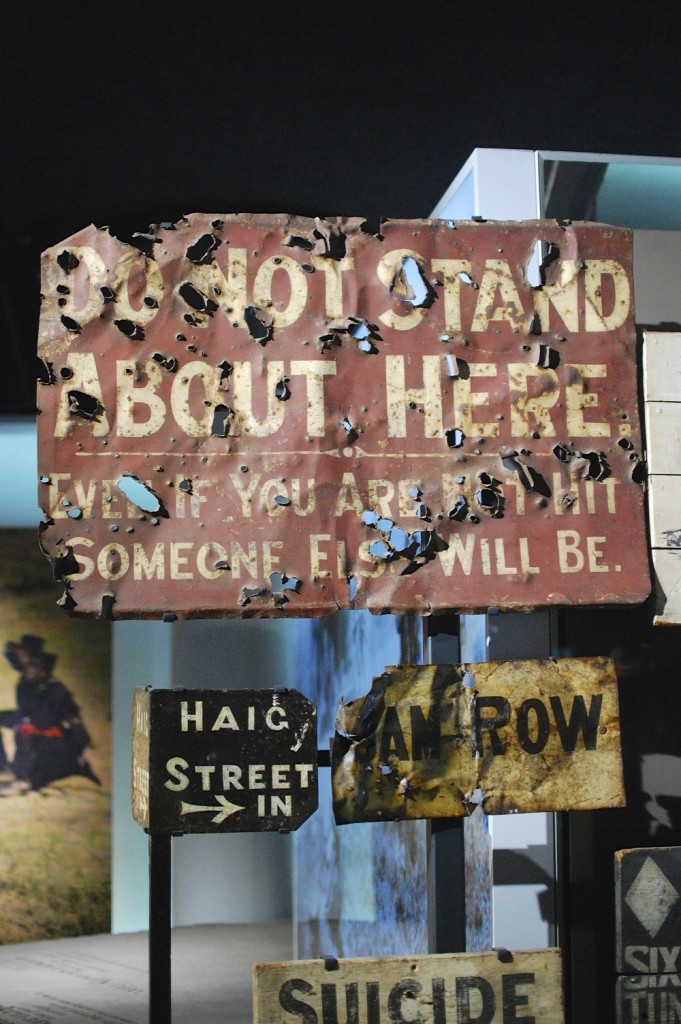On Security will be on holiday until 2016. My dogs, Admiral Horatio Nelson and Sir Winston Churchill, and I extend our warmest wishes for a happy holiday and for a healthy and happy new year. I want to thank you, dear readers, for supporting this blog in its first few months, and I look forward to many exciting new posts in 2016.
Category Archives: Photos
Banner Image: Imperial War Museum, London
The image currently serving as the blog’s banner comes from the following photograph taken by my husband Robert P. Chamberlain:
 The two signs that feature in the banner are part of a larger assembly of signs that stood at various “no-man’s-land” locations during World War I. They featured in a special exhibit on the Great War at the Imperial War Museum in London, UK, in the summer of 2014 to mark one hundred years since the start of the war. I visited the museum that summer as part of a research trip to the British national archives in service of my current project on British and French decision making in the Second World War.
The two signs that feature in the banner are part of a larger assembly of signs that stood at various “no-man’s-land” locations during World War I. They featured in a special exhibit on the Great War at the Imperial War Museum in London, UK, in the summer of 2014 to mark one hundred years since the start of the war. I visited the museum that summer as part of a research trip to the British national archives in service of my current project on British and French decision making in the Second World War.
This past March, I travelled to Paris, France, to visit the National Archives and the archives of the Foreign Ministry for the same project. As part of the trip, my husband and I visited the Musée de l’Armée at les Invalides (better known to school tour groups as the site of Napoleon I’s tomb). We spent a considerable amount of time at the “Two World Wars” exhibit, which focused on the French experience.
What was most interesting about the French exhibit was that it covered the period 1871-1945. That is, for the French, the history of the world wars begins with the French defeat in 1871 in the Franco-Prussian War. The British exhibit at the Imperial War Museum begins, as one might expect, with the events in the summer of 1914. The contrast between the two approaches to the same conflict prompted me to think about the very different ways in which different countries can understand the same events, and the way in which those events can come to have very different meanings in the context of different national cultures. I think about the American impression of the world wars (and what I was taught in high school history courses): we have a vague belief that the United States swooped in to win the First World War for the good guys, and a much stronger sense of our “Saving Private Ryan,” guardian-of-freedom triumph in the Second World War. This is not to diminish the United States’ contribution to either of those conflicts, but I doubt that the average American knows that the vast majority of German soldiers killed in WWII died fighting Soviet forces on the Eastern Front or that the French lost more than 10 times as many military dead as did the United States in absolute terms during the First World War. I had never even heard of the Franco-Prussian War before graduate school.
The exhibits I visited over the past two years suggest that the British and French see the world wars as intimately connected, and the French view the 1871 conflict as intrinsically tied to the other two; I think the United States tends to view the two world wars as relatively disconnected events that happened “over there” in the first half of the twentieth century. Differences in national memory and national legend can, I think, affect the ways in which we perceive both past and current events in international politics.
In other news, the United States has decided to suspend the program for training Syrian rebels; instead, we are going to be identifying appropriate indigenous forces to give American equipment. The New York Times notes that, “failure on the battlefield or the loss of weapons that could fall into the hands of extremists could result in a cutoff of military equipment, officials said.” Well as long as we’ll be cutting off additional transfers of weapons after the equipment has fallen into the hands of extremists, what could go wrong?

